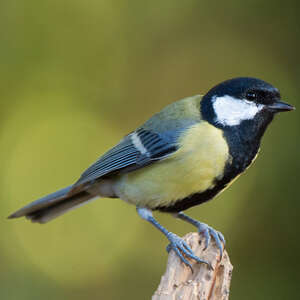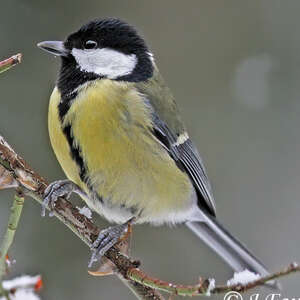Great Tit
Parus major - Mésange charbonnière
Identification
The Great Tit is a large tit, the largest of the ones we encounter in the west of the continent. It is remarkable for its black head with large white cheeks. The very dark eye is drowned in the black. The upper body, coat and back, is greenish with a lighter area on the nape. The dark wings and tail are distinctly grey with a blue hue. A white wing bar stands out on the large coverts. The underside is yellow, but lightens towards the tail. The back of the flanks is grey. The belly and undertail coverts are white with a black median line on the latter. A black mid-ventral band runs from the throat to the belly, wide and deep black in the male adult, more restricted and irregular in the female. This sexual dimorphism is only evident in adults. From underneath the tail appears to be edged in white. This white on the outer rectrices is clearly visible in flight when the tail is open. The beak is black and the legs are greyish blue. The juvenile has more muted colours than the adult. The black on the head is dull. The cheeks are washed with yellow. The ventral black band is barely visible. It is only in the post-juvenile molt that the plumage becomes more in line with what is expected of the species. There used to be (36) very numerous subspecies of Great Tit, sense lato, which differed mostly regarding their colour. The major subspecies occupying the continental Europe, very colourful as seen earlier, is at the westernmost end of a cline which in the Far East gives subspecies such as cinereus or nipalensis which have lost the yellow of the plumage and are entirely black, white and shades of grey. These have recently been raised to the rank of species, so that the current number of subspecies of Parus major stricto sensu is 16.
Subspecific information 16 subspecies
- Parus major major (mainland Europe to w and sc Siberia, the Caucasus and Asia Minor)
- Parus major newtoni (British Isles)
- Parus major kapustini (se Kazakhstan and nw China to Mongolia and e Siberia)
- Parus major corsus (Portugal, s Spain and Corsica)
- Parus major mallorcae (Balearic Is.)
- Parus major excelsus (nw Africa)
- Parus major ecki (Sardinia)
- Parus major aphrodite (s Italy, s Greece, the Aegean Is. and Cyprus)
- Parus major niethammeri (Crete)
- Parus major terraesanctae (Syria to ne Egypt)
- Parus major karelini (se Azerbaijan and nw Iran)
- Parus major blanfordi (n Iraq, nc and sw Iran)
- Parus major bokharensis (Turkmenistan and n Afghanistan to sc Kazakhstan and Uzbekistan)
- Parus major turkestanicus (se Kazakhstan to sw Mongolia)
- Parus major ferghanensis (Tajikistan and Kyrgyzstan to w China)
- Parus major intermedius (ne Iran and sw Turkmenistan)
Foreign names
- Mésange charbonnière,
- Carbonero común,
- chapim-real,
- Kohlmeise,
- széncinege,
- Koolmees,
- Cinciallegra,
- talgoxe,
- Kjøttmeis,
- sýkorka veľká,
- sýkora koňadra,
- Musvit,
- talitiainen,
- mallerenga carbonera,
- Flotmeisa,
- bogatka (zwyczajna),
- lielā zīlīte,
- velika sinica,
- Большая синица,
- ヨーロッパシジュウカラ,
- 大山雀,
- talgoxe,
- 大山雀,
Voice song and call
The Great Tit is very vocal all year round. It has a fairly varied repertoire (40 distinct known notes) with some constants. The song is a simple phrase that can be rendered by tsi tu or hu dit or ti du, repeated for a long time, sometimes trisyllabic tsi tsi tu. Contact calls are small sharp tit. A tsi de de is close to one of the calls of the Marsh Tit. One of the usual cries, a fint, is similar to the usual cry of the chaffinch, to fool. A psi psi hin hin hin hin is frequent. Also a chchchchchch. Others are untranslatable. East birds coming in France would recognize themselves by their doubled cry huit huit.
Habitat
The Great Tit is a forest bird that frequents many different habitats including coniferous forests, but has a preference for deciduous forests.
Behaviour character trait
The Great Tit is a common species in close contact with humans. During the breeding period, it lives in forests and forms territorial couples that protect their domains, becoming very aggressive towards its species. Out of this period, it becomes gregarious and forms with its peers and other species of titmice, or even with other birds like chaffinches and treecreepers, loose flocks that wander searching for food in all wooded surroundings. This is commonly known as titmice parade. This offers them an advantage in protection from predators, as well as to detect sources of food.
It is a cave dweller while breeding, as it builds its nest in all kinds of hollows, natural or artificial. It is very easy to attract one to an artificial nesting box. It can also take over surprising places like mailboxes. On the contrary, hollow poles are very dangerous, as the birds can get inside them in search of a nesting site and get stuck due to their narrowness and depth. It is unfortunately common to find poles full of corpses of birds, titmice and others, who have been trapped. In France, electric or phone staff routines usually include the use of adapted devices to close the poles. The Great Tit looks for food among the trees' vegetation, but also on the ground. It is equipped with a strong pointed beak, that it can use to pierce or break thick-shelled seeds, as well as robust and clawed legs, that it uses to secure its prey or seed before pecking it.The particular legs of the Great Tit, like all other tits, are an adaptation to arboreal life. They allow for easily grasping twig and branches, gripping tree trunks laterally, and even hanging upside down to explore inaccessible areas such as under the branches, terminal buds, and conifer cones. In the winter, this is a classic species of bird feeders that is interested in animal-based food, like fat, as well as fatty seeds like sunflower seeds. The fat is consumed on site, while the seeds are picked up in the beak and brought to a nearby branch to crack. This species is typically considered a sedentary species throughout its range. At best, there is some inter-nuptial erratism guided by the search for food or for small altitudinal displacements.Flight
The flight of the Great Tit is direct and undulating. Its relatively short wings are signs of its sedentary nature. They allow it to be very agile in the forest environment it frequents throughout the year. Its wings also serve it during the nuptial parade at the time of the formation of couples.
Dietfeeding habits
The Great Tit has a diverse diet that can be split into two parts. In the breeding season, the diet is mostly based on animal food and is highly insectivorous.
It is known that the Great Tit's reproduction is dependent on the availability of caterpillars that are mainly used to feed the young. This diet can be supplemented by other invertebrates such as various insects and spiders, if needed. There can be good and bad years for caterpillars. In the interim period, it turns to other sources of food such as fruits and seeds. The Great Tit is unwelcome in orchards where it may attack the fruits but not always consume them fully, although its damages are far lesser than those caused by starlings, for example. It is mainly the seeds that will help it survive the winter. This is why it easily comes to the bird feeders to collect the sunflower seeds that its powerful beak is strong enough to crack.Reproduction nesting
Nesting is mainly during spring, from April to June, all across the temperate zones of the Palearctic. The nest is built within a tree cavity or rock crevice, always away from any direct sight. It is made of various materials, such as leaves, herbs and moss, with the moss usually dominating the superstructure, while fur and feathers line the cup where the eggs will be laid. The amount of moss depends on the size of the space available; from minimal to multiple amounts and more. For example, when in a letterbox, birds will gather a lot of moss to occupy the space, with the cup being placed in the farthest and darkest corner possible unless the postie passes by every day.
The entrance needs to be at least 25mm wide for the Great Tit to fit in. Building the nest is the job of the female, fed by the male who in turn takes care of protecting the territory. As these birds have a strategy of reproduction based on great prolificacy, the number of eggs laid per clutch is usually quite high, with the female being able to lay up to 18 eggs, usually falling between 5 and 12. Incubation lasts 13 to 14 days and the stay in the nest for around 3 weeks, and it will take three more weeks for the young to become fully independent. Second twosomes are quite common in normal conditions, resulting in a large number of fledglings every year. The young birds are usually fed highly energetic foods such as caterpillars, since the Great Tit doesn't store food within its throat pouch, therefore having comparatively frequent feeding with an estimate of up to 900 billfuls per day by a single couple. Although they are generally well-protected within the cavity, eggs or young are still at risk of predation.The Greater Spotted Woodpecker for example is known for attacking the broods or nests of Great Tits, widening the entrance with its beak if necessary.Geographic range
The Great Tit of the old definition has a wide distribution across the entire Eurasian continent from Western Europe to Japan, at moderate latitudes, slightly spilling over into Northern Africa. It can also be found in tropical conditions in India, China and Indochina. Three taxa are even found in Indonesia at the equator. The Great Tit in the strict sense this time, Parus major, occupies on the continent a northern strip that goes from the Atlantic to Eastern Siberia including all of Europe, the Maghreb and Asia Minor, reaching the south of northern Iran and following Siberia through the Altai and Mongolia.
Threats - protection
IUCN conservation status
concern
in the Wild
threatened
evaluated
The Great Tit isn't threatened at the moment. It is common and widely spread in its habitat. In France, it is protected by the law like the majority of birds.
Sources of information
- IOC World Bird List (v15.1), Gill, F and D Donsker (Eds). 2025-12-07.
Other sources of interest
 Specification sheet created on
07/07/2023 by Jean François
Specification sheet created on
07/07/2023 by Jean FrançoisTranslation by AI Oiseaux.net
© 1996-2026 Oiseaux.net
- Accipitriformes
- Aegotheliformes
- Anseriformes
- Apodiformes
- Apterygiformes
- Bucerotiformes
- Caprimulgiformes
- Cariamiformes
- Casuariiformes
- Charadriiformes
- Ciconiiformes
- Coliiformes
- Columbiformes
- Coraciiformes
- Cuculiformes
- Eurypygiformes
- Falconiformes
- Galliformes
- Gaviiformes
- Gruiformes
- Leptosomiformes
- Mesitornithiformes
- Musophagiformes
- Nyctibiiformes
- Opisthocomiformes
- Otidiformes
- Passeriformes
- Pelecaniformes
- Phaethontiformes
- Phoenicopteriformes
- Piciformes
- Podargiformes
- Podicipediformes
- Procellariiformes
- Psittaciformes
- Pterocliformes
- Rheiformes
- Sphenisciformes
- Steatornithiformes
- Strigiformes
- Struthioniformes
- Suliformes
- Tinamiformes
- Trogoniformes


































